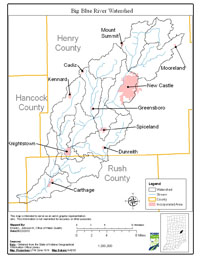Location
The Big Blue River Watershed is located in east central Indiana, draining approximately 53.87 square miles in Henry and Rush counties. Major streams included in the Total Maximum Daily Load (TMDL) report are Big Blue River, Buck Creek, Duck Creek, Little Blue River and Montgomery Creek.
History
A comprehensive survey of the Big Blue River Watershed was conducted by Indiana Department of Environmental Management (IDEM) from June 3, 2002 to July 17, 2002. The primary cause of impairment is Escherichia coli bacteria (E. coli). Pollution sources in the watershed include nonpoint sources from agriculture and pastures, land application of manure and urban and rural run-off, as well as point sources from straight pipe discharges, home sewage treatment system disposal and combined sewer overflow outlets.
Pollutants Addressed
TMDLs for the Big Blue River Watershed are established for E. coli and will address 13 impairments. Some of the recommended solutions to address the impairments include storm water controls, point source controls, manure management and habitat improvements.
Timeline
A kickoff TMDL meeting was held on December 7, 2005 at the Carthage Ripley Community Center, Mill Street and Main Street, Carthage, Indiana starting at 2:00 p.m. and at the Big Blue River Conservancy District, Westwood Park, 1894 South County Road 275 West, New Castle, Indiana starting at 6:00 p.m.
A draft TMDL meeting was held on April 18, 2006 at the Big Blue River Conservancy District, Westwood Park, 1894 South County Road 275 West, New Castle, Indiana starting at 6:00 p.m.
The 30-day public comment period for the draft Big Blue Watershed TMDL began on April 3, 2006 and ended on May 5, 2006.
U.S. EPA under Section 303(d) of the Clean Water Act approved the Big Blue River Watershed TMDL report on July 31, 2006 for 13 impairments. TMDL reports identify and evaluate water quality problems in impaired water bodies and propose solutions to bring those waters into attainment with water quality standards.

